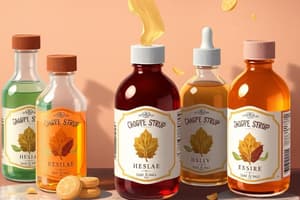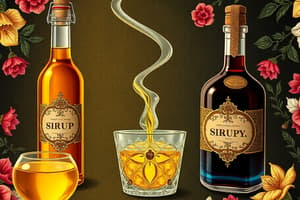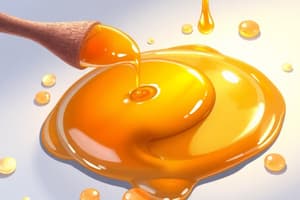Podcast
Questions and Answers
Syrups can be classified into medicated and non-medicated syrups.
Syrups can be classified into medicated and non-medicated syrups.
True (A)
Sugar-free syrups contain natural sweetening agents like sucrose.
Sugar-free syrups contain natural sweetening agents like sucrose.
False (B)
Sucrose is the preferred carbohydrate for syrups due to its high purity and sweetness.
Sucrose is the preferred carbohydrate for syrups due to its high purity and sweetness.
True (A)
In syrup formulations, the viscosity is always low.
In syrup formulations, the viscosity is always low.
Hydrolysis is one of the degenerative pathways that sucrose can undergo in aqueous solutions.
Hydrolysis is one of the degenerative pathways that sucrose can undergo in aqueous solutions.
Sugar-based syrups are less viscous compared to sugar-free syrups.
Sugar-based syrups are less viscous compared to sugar-free syrups.
Fermentation in sucrose solutions can lead to changes in color, odor, and taste.
Fermentation in sucrose solutions can lead to changes in color, odor, and taste.
Syrups that are nearly saturated are self-preserving in good storage conditions.
Syrups that are nearly saturated are self-preserving in good storage conditions.
Sucrose undergoes hydrolysis to form levulose and glucose.
Sucrose undergoes hydrolysis to form levulose and glucose.
The hydrolysis of sucrose results in a solution that rotates polarized light to the right.
The hydrolysis of sucrose results in a solution that rotates polarized light to the right.
Dextrose-based syrups do not require preservatives due to their lower fermentation capabilities.
Dextrose-based syrups do not require preservatives due to their lower fermentation capabilities.
Dextrose has a sweetness rating of 173%.
Dextrose has a sweetness rating of 173%.
Caramelization occurs in syrups containing strong acids and can lead to discoloration.
Caramelization occurs in syrups containing strong acids and can lead to discoloration.
A saturated solution of dextrose is more viscous than a simple syrup.
A saturated solution of dextrose is more viscous than a simple syrup.
The only official syrup using dextrose is hydroiodic acid (HI) syrup.
The only official syrup using dextrose is hydroiodic acid (HI) syrup.
Levulose has a greater capacity to rotate polarized light than dextrose.
Levulose has a greater capacity to rotate polarized light than dextrose.
Flashcards are hidden until you start studying
Study Notes
Syrups
- Syrups are concentrated aqueous solutions of sugar with optional medicinal or flavoring ingredients.
- They are characterized by their sweet taste and high viscosity.
Types of Syrups
- Non-medicated syrups: Used as a vehicle for other preparations.
- Medicated syrups: Contain active pharmaceutical ingredients (APIs) and have therapeutic effects, examples include antihistamines and cough syrups.
- Sugar-based syrups: Made with concentrated sugar solutions, primarily sucrose or dextrose.
- Sugar-free syrups: Use artificial sweeteners and viscosity builders.
- Often used for diabetic patients who need to restrict their sugar intake.
- Require the addition of viscosity builders like glycerin, methylcellulose, or hydroxyethyl cellulose to achieve the desired consistency.
Sucrose-Based Syrups
- Sucrose is the preferred sugar for syrups because it is pure, readily dissolves, has a high sweetness rating, and is inert.
- Stability of sucrose-based syrups:
- Sucrose is susceptible to fermentation and hydrolysis in aqueous solutions.
- Fermentation:
- Microorganisms (moulds and yeast) can grow in dilute solutions of sucrose, leading to turbidity, odor changes, and taste changes.
- Nearly saturated sucrose solutions (close to maximum solubility) are self-preserving as there is limited free water available for microbial growth.
- Preservatives (benzoic acid, sodium benzoate) are often added to syrups at a concentration of 0.1-0.2% w/v.
- Hydrolysis:
- Sucrose breaks down into glucose (dextrose) and fructose (levulose) with the presence of acids and heat.
- This process is known as "inversion" because the solution rotates polarized light differently after hydrolysis.
- Inverted sugar solutions ferment more easily, are sweeter than sucrose alone, and can lead to browning of the syrup (caramelization) due to the formation of fructose.
Dextrose-Based Syrups
- Dextrose can be used to replace sucrose in syrups containing strong acids, preventing the browning associated with sucrose hydrolysis.
- Differences between sucrose and dextrose:
- Dextrose solutions are less viscous than sucrose solutions, with a saturation point of 70% w/v.
- Dextrose dissolves slower than sucrose.
- Dextrose is less sweet than sucrose (74% sweetness).
- Dextrose solutions are more easily fermented than saturated sucrose solutions (not self-preserving).
- Preservatives, like glycerin (30-45% v/v), are often required for dextrose-based syrups. Glycerin contributes to viscosity and sweetness.
Studying That Suits You
Use AI to generate personalized quizzes and flashcards to suit your learning preferences.




